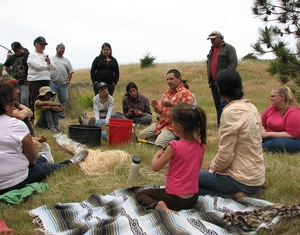Campus News
Reviving deep-rooted knowledge
The Amah Mutsun Relearning Program at the Arboretum & Botanic Garden aims to assist the tribe’s efforts in cultural revitalization, recuperation and relearning of dormant cultural knowledge, and environmental justice.


Long thought of incorrectly as hunter-gatherers, the California Indigenous tribe the Amah Mutsun were actually careful tenders of the land.
UC Santa Cruz’s Arboretum & Botanic Garden honors this heritage in a 40-acre garden filled with native plants. The Amah Mutsun Relearning Program, founded in 2009, gives tribal members and university students a chance to get up close to plants the ancestors interacted with regularly.
“The people before first contact were very effective at stewarding and taking care of Mother Earth,” said Valentin Lopez, chair of the Amah Mutsun Tribal Band. “Those plants represent thousands of years of care and tending and intentional stewardship.”
The Relearning Program presents educational gatherings about everything from how to make acorn mush to how to turn grass seed into foods and make fires, said Rick Flores, the program’s steward and a UC Santa Cruz alum who attended College Eight (now Rachel Carson College) as an undergrad and earned bachelor’s (1997) and master’s degrees (2017) in environmental studies.
While most events have been suspended since the COVID-19 pandemic, Flores has continued to give lectures through Zoom, offer tours to undergraduates and community organizations, and assist with connecting faculty to the tribe. He hopes to start up onsite programs again this spring or summer.
Plants in the garden came from a list given to the Arboretum by the Amah Mutsun. Tribe members selected plants that are culturally important, such as white root sedge and deergrass, which were used to make watertight cooking baskets, Flores said. Tribe members are invited to tend or harvest as they like.
The Relearning Program also uses information from Smithsonian ethnographer John P. Harrington’s extensive interviews with revered tribal elder Ascension Solorsano just before her death. According to Gilroy’s Ascension Solorsano Middle School website, Solarsano was happy to share her knowledge.
“You are a vehicle of God,” she said, according to the web site, “that comes to see me in the 11th hour to save my knowledge from being lost. I will teach you up to the last day I can and see if I can tell you all that I know.”
Flores said Solarsano’s interviews are a treasured resource. “She left an incredible body of cultural knowledge,” he said.
Research shows that the Amah Mutsun figured out ways to sustain the ecosystems and cultivate plant populations so they could rely on them year after year.
“They weren’t domesticating plants, they weren’t farming, but they were cultivating plants,” he said. “This is a type of proto-agriculture.”
The Amah Mutsun knew a lot about plant medicines, but you won’t hear about them from the Relearning Program. The tribe has specifically asked the Arboretum not to talk about that because of the potential dangers. The medicines are complicated—their uses and effectiveness depend on several factors like where the plant is growing, what light it gets, what kind of soil it is growing in, and what prayers are said at harvesting time, Flores said. The tribe doesn’t think that information should be shared with the public.
The Amah Mutsun tribe has 800 enrolled members who are descendants of Indigenous groups taken to Mission Santa Cruz and Mission San Juan Bautista during the times of Spanish colonization on the coast. Often referred to as “Ohlone,” they came from many bands, villages, and communities that had similar languages and intermarried and traded with each other.
Today, most of the tribe’s members do not live in the area anymore. Back in the early 1900s, there was a large movement of tribal members into the Central Valley to work on farms and ranches.
“They’re a poor tribe and they are not federally recognized,” Flores said.
The Amah Mutsun Land Trust is the vehicle the tribe uses to collaborate with environmental organizations and public, state, and federal land owners so they can gain access to their traditional territories.
Lopez, the chair of the tribe, said he appreciates the partnership with UC Santa Cruz as a way to preserve valuable Indigenous knowledge.
“The Indigenous people of the area have been ignored and forgotten,” he said. “People don’t know who they were.”
To tribe members, every plant is a relative, Lopez said. Humans and plants have the same parents—Mother Earth and Father Sky.
“We want to treat [plants] with kindness and love, sing to them, and have relationships with them,” he said. “People do not do that these days and they don’t understand that.”
Native California plants are special because they develop deep root systems that are 15 to 20 feet deep, Lopez said. This makes them resistant to drought, flooding, and disease.
“If you look at climate change, these are the plants that are important,” he said.
Lopez enjoys going to the garden when he can to harvest plants.
“We have a good relationship with the Arboretum,” he said. “They are one of the first ones we established a relationship with. Because of that, we’ve maintained a close relationship ever since. We collaborate on a lot of things.”